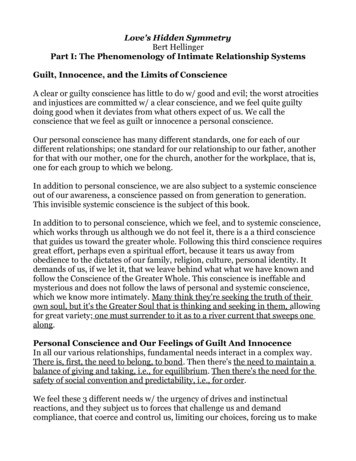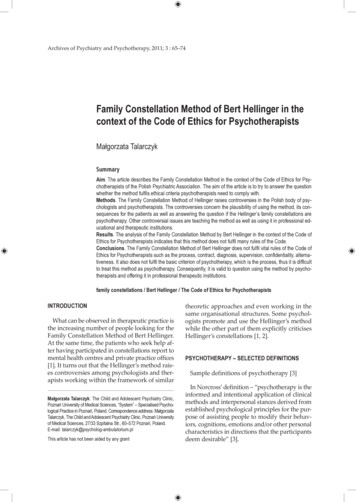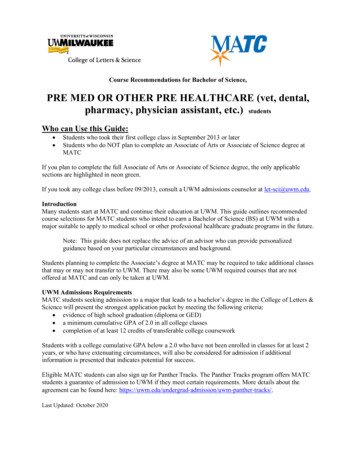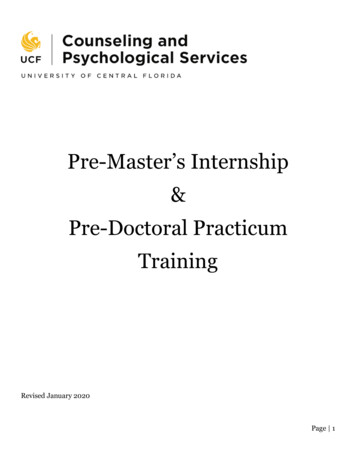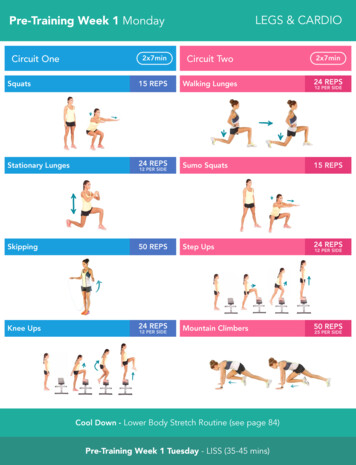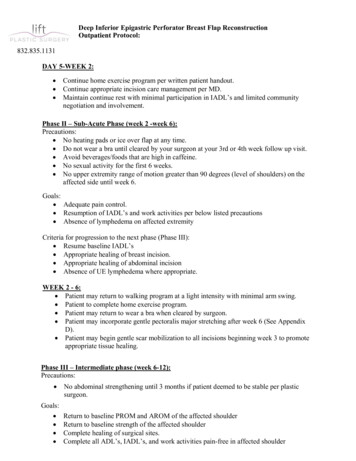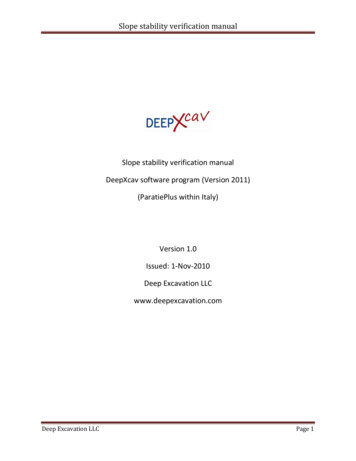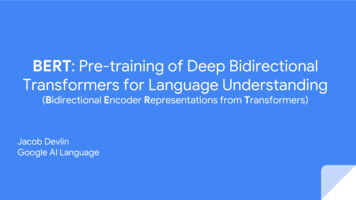
Transcription
BERT: Pre-training of Deep BidirectionalTransformers for Language Understanding(Bidirectional Encoder Representations from Transformers)Jacob DevlinGoogle AI Language
Pre-training in NLP Word embeddings are the basis of deep learningfor NLPking[-0.5, -0.9, 1.4, ]queen[-0.6, -0.8, -0.2, ] Word embeddings (word2vec, GloVe) are oftenpre-trained on text corpus from co-occurrencestatisticsInner Productthe king wore a crownInner Productthe queen wore a crown
Contextual Representations Problem: Word embeddings are applied in acontext free manneropen a bank accounton the river bank[0.3, 0.2, -0.8, ] Solution: Train contextual representations on textcorpus[0.9, -0.2, 1.6, ]open a bank account[-1.9, -0.4, 0.1, ]on the river bank
History of Contextual Representations Semi-Supervised Sequence Learning, Google,2015Train LSTMLanguage ModelopenabankLSTMLSTMLSTM s openaFine-tune onClassification TaskPOSITIVE.LSTMLSTMLSTMveryfunnymovie
History of Contextual Representations ELMo: Deep Contextual Word Embeddings, AI2 &University of Washington, 2017Train Separate Left-to-Right andRight-to-Left LMsopenabank s openaLSTMLSTMLSTMLSTMLSTMLSTM s openaopenabankApply as “Pre-trainedEmbeddings”Existing Model Architectureopenabank
History of Contextual Representations Improving Language Understanding by GenerativePre-Training, OpenAI, 2018Train Deep (12-layer)Transformer LMabankTransformerTransformerTransformer s openaopenFine-tune onClassification TaskPOSITIVETransformerTransformerTransformer s opena
Problem with Previous Methods Problem: Language models only use left contextor right context, but language understanding isbidirectional. Why are LMs unidirectional? Reason 1: Directionality is needed to generate awell-formed probability distribution. We don’t care about this. Reason 2: Words can “see themselves” in abidirectional encoder.
Unidirectional vs. Bidirectional ModelsUnidirectional contextBuild representation incrementallyBidirectional contextWords can “see themselves”openabankopenabankLayer 2Layer 2Layer 2Layer 2Layer 2Layer 2Layer 2Layer 2Layer 2Layer 2Layer 2Layer 2 s opena s opena
Masked LM Solution: Mask out k% of the input words, andthen predict the masked words We always use k 15%storegallonthe man went to the [MASK] to buy a [MASK] of milk Too little masking: Too expensive to train Too much masking: Not enough context
Masked LM Problem: Mask token never seen at fine-tuning Solution: 15% of the words to predict, but don’treplace with [MASK] 100% of the time. Instead: 80% of the time, replace with [MASK]went to the store went to the [MASK] 10% of the time, replace random wordwent to the store went to the running 10% of the time, keep samewent to the store went to the store
Next Sentence Prediction To learn relationships between sentences, predictwhether Sentence B is actual sentence thatproceeds Sentence A, or a random sentence
Input Representation Use 30,000 WordPiece vocabulary on input. Each token is sum of three embeddings Single sequence is much more efficient.
Model ArchitectureTransformer encoder Multi-headed self attention Models context Feed-forward layers Computes non-linear hierarchical features Layer norm and residuals Makes training deep networks healthy Positional embeddings Allows model to learn relative positioning
Model Architecture Empirical advantages of Transformer vs. LSTM:1. Self-attention no locality bias Long-distance context has “equal opportunity”2. Single multiplication per layer efficiency on TPU Effective batch size is number of words, not sequencesTransformerX 0 0X 0 1X 0 2LSTMX 0 3X 0 0 X 1 0X 1 1X 1 2X 1 3X 0 1X 0 2X 0 3 WX 1 0X 1 1X 1 2X 1 3W
Model Details Data: Wikipedia (2.5B words) BookCorpus (800Mwords) Batch Size: 131,072 words (1024 sequences * 128length or 256 sequences * 512 length) Training Time: 1M steps ( 40 epochs) Optimizer: AdamW, 1e-4 learning rate, linear decay BERT-Base: 12-layer, 768-hidden, 12-head BERT-Large: 24-layer, 1024-hidden, 16-head Trained on 4x4 or 8x8 TPU slice for 4 days
Fine-Tuning Procedure
GLUE ResultsMultiNLIPremise: Hills and mountains are especiallysanctified in Jainism.Hypothesis: Jainism hates nature.Label: ContradictionCoLaSentence: The wagon rumbled down the road.Label: AcceptableSentence: The car honked down the road.Label: Unacceptable
SQuAD 1.1 Only new parameters:Start vector and endvector. Softmax over all positions.
SQuAD 2.0 Use token 0 ([CLS]) to emitlogit for “no answer”. “No answer” directlycompetes with answer span. Threshold is optimized on devset.
SWAG Run each Premise Endingthrough BERT. Produce logit for each pairon token 0 ([CLS])
Effect of Pre-training Task Masked LM (compared to left-to-right LM) is very important onsome tasks, Next Sentence Prediction is important on other tasks.Left-to-right model does very poorly on word-level task (SQuAD),although this is mitigated by BiLSTM
Effect of Directionality and Training Time Masked LM takes slightly longer to converge becausewe only predict 15% instead of 100% But absolute results are much better almost immediately
Effect of Model Size Big models help a lot Going from 110M - 340M params helps even ondatasets with 3,600 labeled examples Improvements have not asymptoted
Effect of Masking Strategy Masking 100% of the time hurts on feature-based approach Using random word 100% of time hurts slightly
Multilingual BERT Trained single model on 104 languages from Wikipedia. Shared 110kWordPiece vocabulary.System EnglishChineseSpanishXNLI Baseline - Translate Train73.767.068.8XNLI Baseline - Translate Test73.768.470.7BERT - Translate Train81.976.677.8BERT - Translate Test81.970.174.9BERT - Zero Shot81.963.874.3XNLI is MultiNLI translated into multiple languages.Always evaluate on human-translated Test.Translate Train: MT English Train into Foreign, then fine-tune.Translate Test: MT Foreign Test into English, use English model.Zero Shot: Use Foreign test on English model.
Synthetic Training Data1. Use seq2seq model to generate positive questions fromcontext answer.2. Heuristically transform positive questions into negatives(i.e., “no answer”/impossible). Result: 3.0 F1/EM score, new state-of-the-art.
Synthetic Training Data1. Pre-train seq2seq model on Wikipedia. Encoder trained with BERT, Decoder trained to decode nextsentence.2. Fine-tune model on SQuAD Context Answer Question Ceratosaurus was a theropod dinosaur in the Late Jurassic, around 150 million yearsago. - When did the Ceratosaurus live ?3. Train model to predict answer spans withoutquestions. Ceratosaurus was a theropod dinosaur in the Late Jurassic, around 150 million yearsago. - {150 million years ago, 150 million, theropod dinsoaur, Late Jurassic, inthe Late Jurassic}
Synthetic Training Data4. Generate answer spans from a lot of Wikipediaparagraphs using model from (3)5. Use output of (4) as input to seq2seq model from(2) to generate synthetic questions: Roxy Ann Peak is a 3,576-foot-tall mountain in the Western Cascade Range in theU.S. state of Oregon. What state is Roxy Ann Peak in?6. Filter with baseline SQuAD 2.0 system to throw outbad questions. Roxy Ann Peak is a 3,576-foot-tall mountain in the Western Cascade Range in theU.S. state of Oregon. What state is Roxy Ann Peak in? ( Good)Roxy Ann Peak is a 3,576-foot-tall mountain in the Western Cascade Range in theU.S. state of Oregon. Where is Oregon? ( Bad)
7. Heuristically generate “strong negatives”:a. Positive questions from other paragraphs of same document.What state is Roxy Ann Peak in? When was Roxy Ann Peak first summited?b. Replace span of text with other span of same type (based on POS tags).Replacement is usually from paragraph.What state is Roxy Ann Peak in? What state is Oregon in?What state is Roxy Ann Peak in? What mountain is Roxy Ann Peak in?8. Optionally: Two-pass training, where no-answer ismodeled as regression second pass ( 0.5 F1)
Common Questions Is deep bidirectionality really necessary? What aboutELMo-style shallow bidirectionality on bigger model? Advantage: Slightly faster training time Disadvantages: Will need to add non-pre-trained bidirectional model on topRight-to-left SQuAD model doesn’t see questionNeed to train two modelsOff-by-one: LTR predicts next word, RTL predicts previous wordNot trivial to add arbitrary pre-training tasks.
Common Questions Why did no one think of this before? Better question: Why wasn’t contextual pre-trainingpopular before 2018 with ELMo? Good results on pre-training is 1,000x to 100,000more expensive than supervised training. E.g., 10x-100x bigger model trained for 100x-1,000x as many steps.Imagine it’s 2013: Well-tuned 2-layer, 512-dim LSTM sentiment analysisgets 80% accuracy, training for 8 hours.Pre-train LM on same architecture for a week, get 80.5%.Conference reviewers: “Who would do something so expensive for sucha small gain?”
Common Questions The model must be learning more than “contextualembeddings” Alternate interpretation: Predicting missing words(or next words) requires learning many types oflanguage understanding features. syntax, semantics, pragmatics, coreference, etc. Implication: Pre-trained model is much bigger thanit needs to be to solve specific task Task-specific model distillation words very well
Common Questions Is modeling “solved” in NLP? I.e., is there a reason to comeup with novel model architectures? But that’s the most fun part of NLP research :( Maybe yes, for now, on some tasks, like SQuAD-style QA. At least using the same deep learning “lego blocks” Examples of NLP models that are not “solved”: Models that minimize total training cost vs. accuracy on modern hardwareModels that are very parameter efficient (e.g., for mobile deployment)Models that represent knowledge/context in latent spaceModels that represent structured data (e.g., knowledge graph)Models that jointly represent vision and language
Common Questions Personal belief: Near-term improvements in NLPwill be mostly about making clever use of “free”data. Unsupervised vs. semi-supervised vs. synthetic supervised issomewhat arbitrary.“Data I can get a lot of without paying anyone” vs. “Data I have to paypeople to create” is more pragmatic distinction. No less “prestigious” than modeling papers: Phrase-Based & Neural Unsupervised Machine Translation, FacebookAI Research, EMNLP 2018 Best Paper
Conclusions Empirical results from BERT are great, but biggestimpact on the field is: With pre-training, bigger better, without clearlimits (so far). Unclear if adding things on top of BERT really helpsby very much. Good for people and companies building NLP systems.Not necessary a “good thing” for researchers, but important.
Pre-training in NLP Word embeddings are the basis of deep learning for NLP Word embeddings (word2vec, GloVe) are often pre-trained on text corpus from co-occurrence statistics king [-0.5, -0.9, 1.4, ] queen [-0.6, -0.8, -0.2, ] the king wore a crown Inner Product the queen wore a crown Inner Product. Contextual Representations Problem: Word embeddings are applied in a context free manner .

